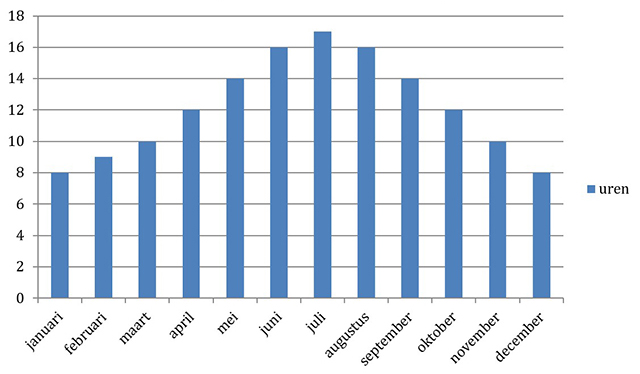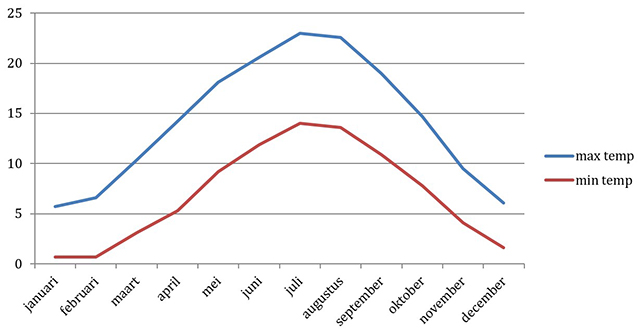
Breeding room
Breeding birds
The desire of man to possess a number of birds, exists already very long. For some it is more a feeling to take care of bird keeping and enjoy their song and beautiful colours, for others it can be the wish to obtain many varieties and participate in exhibitions. Sometimes commercial purposes can also play along.
All this has led to an intensive way of breeding birds. In order to find an efficient way, the birds are often housed in a minimum necessary volume. These breeding facilities are easier to maintain and monitor.
Breeding in natural circumstances
In our region "light" and "temperature" determines the annual reproductive cycle. Breeders using outside aviaries or nest boxes without artificial lighting, are dependent on the natural daylight length. They cannot expect breeding results before April. Indeed, there is a minimum amount of daylight length required for rearing young birds in a good way.
Daylight Length Belgium

Birds in tropical regions, where the days are as long as nights, are stimulated to breed when there is enough food available. The breeding of many Australian finches starts after a period of rainfall since then plants start to grow and hence seeds and food are available.
According to meteorological data, during the past 30 years we have following statistics regarding the average minimum and maximum temperature per month, in Belgium. Successful breeding in natural conditions takes full account of this curve.
Average temperatures in Belgium
Breeding in artificial circumstances
Control of the daylight length
In Belgium people have been breeding canaries, exotic birds and budgerigars for quite a long time and they have changed the normal breeding period. The result is a very sophisticated method of breeding by artificially extending the daily period of illumination.
Breeding of birds no longer happens in outdoors aviaries but in specially designed spaces, both indoors (garage, basement, attic) as on purpose-built premises using breeding cages in which the birds are housed in breeding pairs.
The reasons for using this technique of manipulated breeding are:
- To control the breeding period: a lot of breeders start pairing birds already in the month of February, two months before the normal breeding season, to have finished breeding before their summer holidays.
- To prepare the youngsters for the exhibitions at the end of the year: molt period has to be over.
- To obtain more clutches and youngsters.
Many problems in canary breeding are due to errors in the manipulation of the lighting then to diseases, which are mostly a result of the former. Quite often medication is wrongly used to solve management problems.
The role of the daylight length
Canaries need a minimum of 14 to 15 hours of daylight to start breeding (nest building and production of eggs). With this amount of light, they are also able to feed their youngsters enough and to raise them properly
The amount of daylight hours, as well as the cycle of light, is a major determining factor in whether breeding is sustained or broken off. If the length of the daylight is submitted to fluctuations, the birds will receive different hormonal incentives (negative feedback). The result can be an early moult, so birds will stop breeding.
There are two methods of manipulating the length of daylight:
- Gradually increasing the length of the day
In this case the amount of daylight is gradually increased on a weekly basis. The first period to extend from 8 to 10 hours natural daylight towards 12 hours is not so important. So we can immediately start with 12 hours and then gradually extending the daylight length with a weekly addition of 30 minutes (perhaps 2x a quarter of an hour). Finally it will take another 4 - 6 weeks to obtain the desired 14 – 15 hours for coupling. - Immediately full daylight length
The daylight length can also suddenly be increased from 10 to 15 hours. In this case the birds will reach their breeding condition after 3 to 4 weeks, but are less able to give good results throughout the full breeding season. However, some fanciers do have good results with this method.
Gradually increasing the length of the day is closest to natural stimuli and is used by more than 80 % of the fanciers. 15 hours of daylight length appears to be ideal. More than 17 hours a day gives bad results on an annual basis.
A sudden increase, used by 10 % of the breeders, often leads to bad fertilization of the first clutch (which normalizes afterwards) and higher mortality of females.
Temperature and humidity
The temperature in the breeding room, when starting the breeding, is about 15°C with most of the fanciers. This is regulated with different heating devices (electrical, central heating, gas and petrol). During the breeding season and summer time, the temperature is naturally liable to fluctuations. Therefore good ventilation should be provided, on the one hand to remove exhaust gas, on the other hand to eliminate temperature leaps.
The humidity in the breeding room should be around 60 - 80%. The lower the humidity, the more the development of disease germs will be reduced. When hatching eggs, it is very important to have sufficient humidity. Therefore breeders often moisturize the eggs just before hatching with warm tap water.






